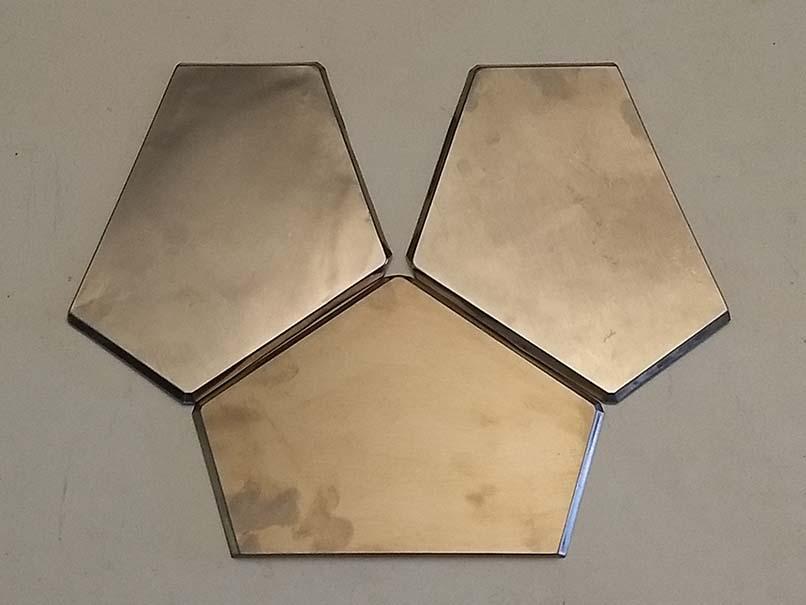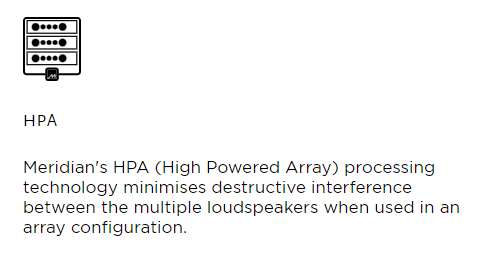- This topic has 9 replies, 7 voices, and was last updated 1 year, 10 months ago by
Evan.
- AuthorPosts
- 27 March 2023 at 07:47 #45022
Just hit my head lately on something and the idea came up to my mind to use 3 pairs of Penta’s to build a (cheaper) alternative for the BL50’s. I have several sets here which I could use for that. The pentagon form would give the option to use 2 penta’s at the both sides of the original Penta to play the same way as with the BL50/90/Theatre/balance/etc.
I know that I would have to make the passive speaker with its 9 drivers active by giving the 3,5 way speaker each section their own amplifier. But the more difficult part would be driving the pairs that would be on both sides playing to the sides and back.
I can think of how to start to convert the penta into active versions with their active dsp filters. But apart from that reasonable difficult task on getting that right, how and what would you send to the other Penta’s at the side. It needs to have some kind of ANC for correcting unwanted room acoustics.
How would one start and would it doable without using specialized rooms for measurements?
I am also hoping that Geoff could give a hint on how to start and whether this idea would even be viable.
27 March 2023 at 09:28 #45023Hi Beobuddy, now I know what that loud ‘thump’ was that I heard here up north lately. What a plan :-). Really curious to see how this BeoLab Triple V story develops!
29 March 2023 at 01:03 #45024It’s a crazy idea, which usually appeals, but it also seems like a waste of three pairs of Pentas…
29 March 2023 at 01:43 #45025Check out MiniDSP.com. They likely sell something that would get you to where you want to go. You may find out that when you consider the cost of the speaker equipment (DSP’s, amps, new enclosures, etc.), the necessary test equipment, and the value of your time, that it would be cheaper to just buy the ’50’s ;-). However, I suspect that, in this case, the journey is more important than the destination.
Have you considered doing the project in stages (with each stage having very specific goals)? For example, you could multi-amp and DSP crossover one set of Pentas to make them ultra-linear frequency response. You could also leave the Pentas untouched and do an 6-speaker room correction. At some point you would combine all that you learned in the earlier stages.
I’m looking forward to hearing about whatever you decide to do.
Glitch
29 March 2023 at 02:50 #45026Hi Beobuddy,
I don’t really understand the intention.
It seems that you’re assuming that a Beolab 50 sends the same signals to the three woofers (and again the same signals to the three midranges). This is not true. The signals for each driver are designed to have a different frequency-dependent magnitude and phase response to either constructively or destructively interfere with each other at a distance of 1.5 m or more from the loudspeaker. Those filters were designed using on the three-dimensional response measurements of the individual radiations of each driver.
Or, maybe you’re just intending to convert passive loudspeakers into fully-active versions with your own filter designs, in which case I don’t understand why you need 3 pairs…
So, it’s possible that the result may be cheaper than a pair of Beolab 50s – but I suspect that the cost might be the only parameter you can use to compare them.
Good luck!
-geoff29 March 2023 at 03:15 #45027The pentagon form would give the option to use 2 penta’s at the both sides of the original Penta
Something like this?

Glitch
29 March 2023 at 04:44 #45028@Glitch: Exact something like that.
@ Geoff: I do understand the logic with the BL50, 90’s etc. As I’ve read all your blogs 😉
So, the idea was/is to convert the passive Penta’s into active versions. And as you need the same drivers for the side/back, it seems the easiest way to use the same Penta’s (which would also be active) to send the audio for eq’s compensation.
Not the easiest task, I know. I wasn’t thinking of providing the “side” penta’s the same audio signal.I’ve designed (theoretic) active filters for the penta about almost 10 yrs ago. Bought several Hypex ICE power amplifiers with a separate power supply. But it never got to really building something out of that.
I tried a bit of measuring with a Minidsp Umik-1 USB microphone and REW software some time ago. Just out of curiosity. Was wondering what my set Penta’s would generate. Knowing that the room and (listening)position of the speakers influences the sound a lot, so I am just wondering what adding 2 sets of Penta’s (with probably only using the woofers and mids) would enhance the performance.30 March 2023 at 10:23 #45029Hi Beobuddy,
Nice idea 🙂
You can use cheap used B&O MCL-2P amps to power the Pentas and then use Room EQ Wizard (REW) to optimize and balance the system.
This is pretty easy to do and I think BL50 is doing something like this.
Jens
30 March 2023 at 11:35 #45030One of the things to beware of when using multiple drivers to produce the same signal is that you need to make sure that the highest frequency they produce has a wavelength in air of (roughly) no less than 4 x the distance between the drivers.
So, for example, if your midranges are 15 cm apart, then the highest frequency they should be used for is:
344 / (0.15 * 4) = 573 Hz
The 344 is the speed of sound in air (344 m/s) and the 0.15 is the distance between the centres of the drivers in metres. Note that it’s not strange to find yourself in a position where this rule directly conflicts with the drivers’ capabilities. For example, it’s not hard to get to a place where the drivers are so far apart that they shouldn’t be used at a frequency higher than something that’s LOWER than they should be used for… (Like being 1.8 m tall, standing at the bottom of a 2 m deep pool… this also causes a problem… eventually…) This is why the (front) midranges of the 50s and 90s (and the (front) tweeters of the 90s) are clustered to keep them as close together as possible. (However, in those cases, we’re also relying on the natural directivity of the individual drivers, which, like I said above, are measured in 3D space.)
Of course, this is a rule of thumb and assumes many things (like omnidirectional radiation of the drivers at that frequency, and the assumption that you DON’T want them to cancel anywhere…)
IF you want to do something else – say, to cancel at 90º off axis for example, then you should put the drivers 1/2 of a wavelength of the frequency you want to cancel (still assuming that you have omnidirectional radiation from the drivers…)
I mad some simple animations explaining this here:
https://www.youtube.com/watch?v=1KGeBEWsahY-g
1 April 2023 at 04:11 #45031Great thread, have been wanting to bring up a similar topic as I have contemplated something very similar.
Inspired by a configuration for architectural speakers by Meridian, I wonder if new life could be breathed into BL6000 and BeoLab 8000 speakers by building trios for wall mounting where space might be an issue for some. Meridian offers customers the ability to “array” their in-wall speakers so their customers with very large spaces / longer than usual listening distances (or need much higher SPL in their room). In their demo theater, Meridian uses three sets of three DSP-750 speakers as the L/C/R behind the projection screen. However they are mounted vertically unlike the icon depicts.

- AuthorPosts
- You must be logged in to reply to this topic.





